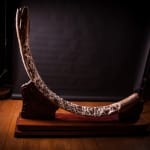-
Artworks





Exceptional Carved Fossil Wooly Mammoth Tusk, 1979
Carved Ivory1450 x 1830 x 250 mmFurther images
Woolly mammoths are perhaps the quintessential Ice Age mammal. Using their tusks to sift the snow looking for vegetation to eat, and ever alert for the crunching snow of a...Woolly mammoths are perhaps the quintessential Ice Age mammal. Using their tusks to sift the snow looking for vegetation to eat, and ever alert for the crunching snow of a predator or man, they inhabited the frozen wastelands of the Pleistocene to the Early Holocene. Approximately the size of an Asian elephant, their double coat of hair and their storage of fat provided warmth. Unlike modern elephants, the woolly mammoth’s ears were small (elephants use their ears to cool themselves and, as the mammoth lived in a cold environment, large ears were unnecessary). The males may have used their tusks for combat or in competition for females.
Fine carving in the Chinese taste covers much of the tusk with various traditional emblems of a happy Buddha, Coins, Clouds etc. Following the ban on elephant ivory in 1972, woolly mammoth tusks became a desirable material to use as a medium for fine Chinese carvings









